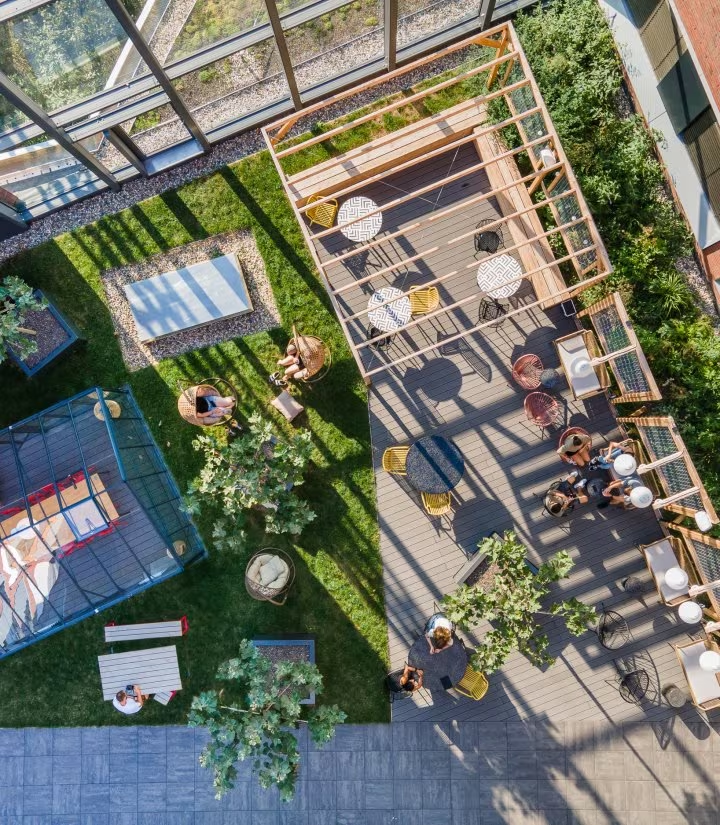Loneliness is at an all time high, but with 1.5 million people moving into cities every week, traditional housing is no longer the answer. This family decided to try and solve the problem.

The siblings and POHA House co-founders: (from left to right) Lea Mishra, Carsten Hermanns, Jochen Hermanns, Anke Tsitouras, Yianni Tsitouras.
Photo credit: Andreas Kuchem
“It’s certainly unconventional, but it’s cool!” says Lea Mishra, on working with her two brothers, Carsten and Jochen Hermanns, plus her sister and husband, Anke and Yianni Tsitouras. Together, the five-strong family group have co‑founded POHA House, a company on a mission to create co-living spaces to fulfil a need for a better way of living.
POHA (pronounced ‘pow-wa’) stands for ‘Pursuit of Happiness’. It is a strong, intentional message that captures the ethos of the co-spaces that promise to help to boost mental, physical and social wellness.
“There was actually a big debate over the name in the beginning,” admits co-founder Yianni (the brother-in-law) with a grin. “It was inspired by a song by the American rapper Kid Cudi about the belief that everyone should pursue their happiness. Jochen came up with it, and it’s a great name.”
The first POHA House, a new-build of two blocks surrounding a garden and joined by a giant communal space on the ground floor, opened its doors right in the heart of Munster in April 2022. Located opposite the Bremer Platz, which buzzes with restaurants and bicycles, it took only three months for all 300 apartments to be occupied. Certainly a source of pride, validation and yes, happiness to the founders.
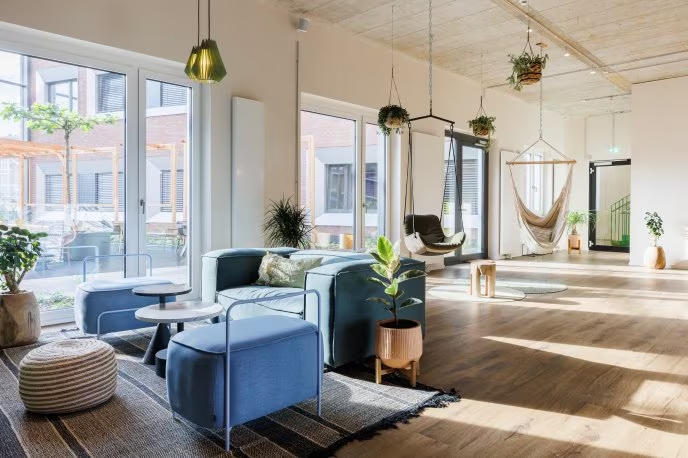
Part of the sunny communal space where the residents gather to socialise, take part in events or cook together
Sharing spaces, gardens, experiences, as well as washing machines and vacuum cleaners, means residents of POHA House have access to so much more than if they lived alone. With rent that covers heating, water, electricity, wifi, all events, a regular charitable donation towards taking plastic out of the ocean, plus a free monthly Monday breakfast (what’s not to love?), it does sound like they’ve thought of everything.
There are two more POHA Houses due to open in Aachen in 2023, with other projects in Essen, Dusseldorf, Hamburg and Frankfurt in the pipeline for 2024-28, all ranging in size from 50 to 300 apartments. The house in Hamburg is particularly exciting for them because, with sustainability at the heart of everything they do, it’s going to be the first residential cradle-to-cradle project in Europe, meaning all the materials they use will be recycled or recyclable. “We’re showing that co-living can be achieved not only in new-builds, but also in conversions,” explains Yianni. “We’ll even be in beautiful listed buildings in Aachen and Essen – and the most sustainable building you can have is the one you don’t have to build.”
We talked to two of the co-founders, Lea Mishra and Yianni Tsitouras to find out more.


Left: Lea Mishra. Photo credit: POHA House
Right: Yianni Tsitouras. Photo credit: Andreas Kuchem
“It’s the appeal of a different kind of living – having the community, but also a space you can be by yourself.”
How did the idea for a co-living house first come about?
Lea: It wasn’t quite over a family dinner, but all of us were thinking about the idea of ‘new living’ for different reasons. I’d lived in Australia, Italy, Hong Kong, and when you arrive at a new place it’s really hard to connect. I then moved into what was probably the first co-living space in Germany in 2016. I loved the concept and the community, but in terms of comfort I didn’t want to be there long.
Yianni: I was living with Anke – now my wife – and we had a flat we couldn’t afford because I’d left my job as a surveyor. So we divided it up to sublet bedrooms and made the living room and kitchen bigger. We’d created this new kind of home. No one even knew what co-living was then, but we realised there was something bigger here.
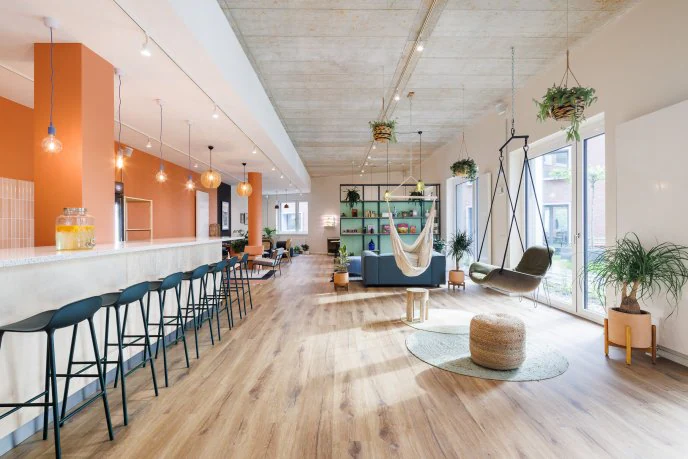
With 600 sq m of living room, the space is big enough for everyone, and flexible enough to accommodate everything from Friday night cocktails to ballet classes
And what is it that makes your residents happy?
Yianni: Being part of this vibrant atmosphere, rather than being alone in a flat, as many of us have been. It’s the appeal of a different kind of living – having the community, but also a space you can be by yourself. But there’s no point having lovely spaces if people don’t use them, so we engage with residents to propose event ideas or create their own clubs. You want to control what goes on in your own home, not be curated to such a degree that it doesn’t feel homely.
Lea: If we all share, we can afford a lot more. In Munster we have 600 sq m of living room, a big kitchen with a dining room, a large private terrace with a co-working glasshouse, a meditation room, yoga sessions, markets, language classes, baking courses, TEDx talks…
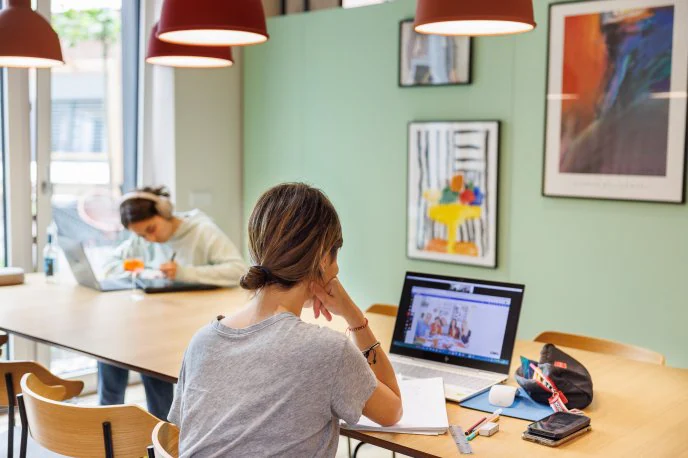
Working in the shared space is more productive and enjoyable than sitting in your room alone
What are the difficulties in creating a space that works for everybody, but makes each person feel it’s also ‘for me’?
Yianni: In Germany if you rent, you buy your own furniture, and put in your own kitchen as well. And then you take that kitchen with you to the next place. So people are embracing the fact they can just move into a furnished apartment. To make them more personal, we’ll provide hanging points for your own pictures, or have art galleries where you can select your own artwork, so you never feel part of a forced design.
Accomplishment is an important part of feeling at home – how do you address that?
Lea: We grow indoor herbs and have a communal garden where the residents choose what to plant. Every Friday we have cocktails, and include the herbs, so today’s drink might be a mint gin and tonic. The community is good at creating cocktail recipes! It’s a lovely way to have a little bit of nature in the middle of the city.
Yianni: And in Hamburg we have a whole veg patch to plant carrots, potatoes, or whatever they want for cooking. So even though you’re in an apartment, you can be outside and grow your own food.
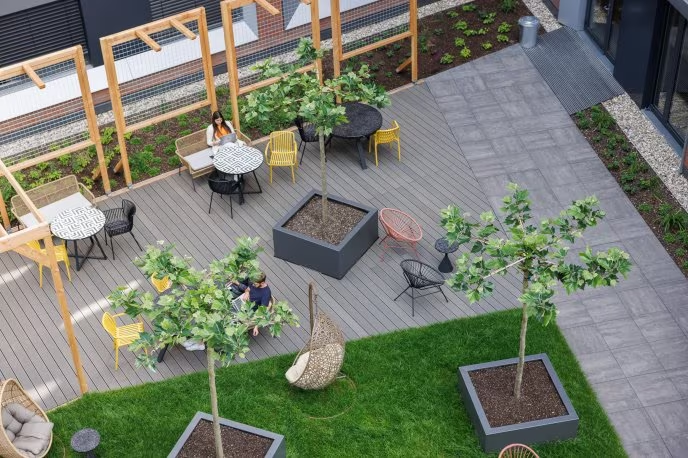
Having a big private garden in the middle of the city is a luxury, otherwise unaffordable to most people living in rented accommodation on their own
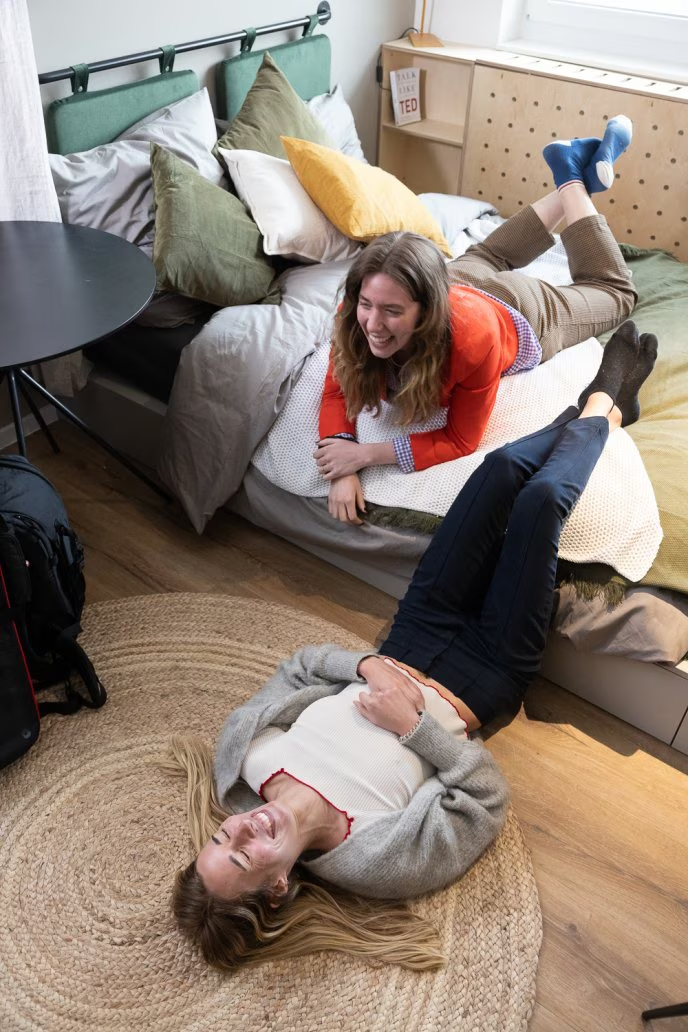
Lea (on the floor) and Miriam, a member of the POHA team, chill out in one of their studio apartments
“No one even knew what co-living was, but we realised there was something bigger here.”
What about those who have more quirky individual interests?
Lea: We had Soup Day recently when a resident made three different sorts of soup because he loves it, and we have someone really into parkour – you know, when you do crazy jumps – and he ran a workshop. Not jumping from the roof though!
Yianni: Because there is a gym a five minute walk away, we didn’t include one, but people really do like to have a gym within their space. So we installed a smart fitness VAHA mirror which has virtual training sessions which is really popular.
Do you have any criteria for people applying to live at POHA House?
Lea: We don’t mind about age or profession. We have people from 18-70 years old, from 40 different nations. But we do have a conversation with them beforehand to figure out if they want to be part of the community. If their intention is right, then it is good for everyone.
Do you live in the building?
Lea: When we opened, I was like “I have to move in because in a way I created this space for myself!” It’s a really cool experience, exhausting though, as I always wake up thinking, “Ah, we should have done this or that differently!” One of us will move in to our new site, once we open, too.
Yianni: I really want to actually. We’ve just had a new baby and I’m trying to convince my wife it would be a great time to be in co-living. I would love to have a community space I could escape to and have a yoga class! Just to realign my mind for 10 minutes.
So there might be a creche in the next building? Will POHA grow with your own needs?
Yianni: We are actually looking at the evolution of the model, and where it can go in the future… this could be the biggest revolution in living we’ve seen in over a century.
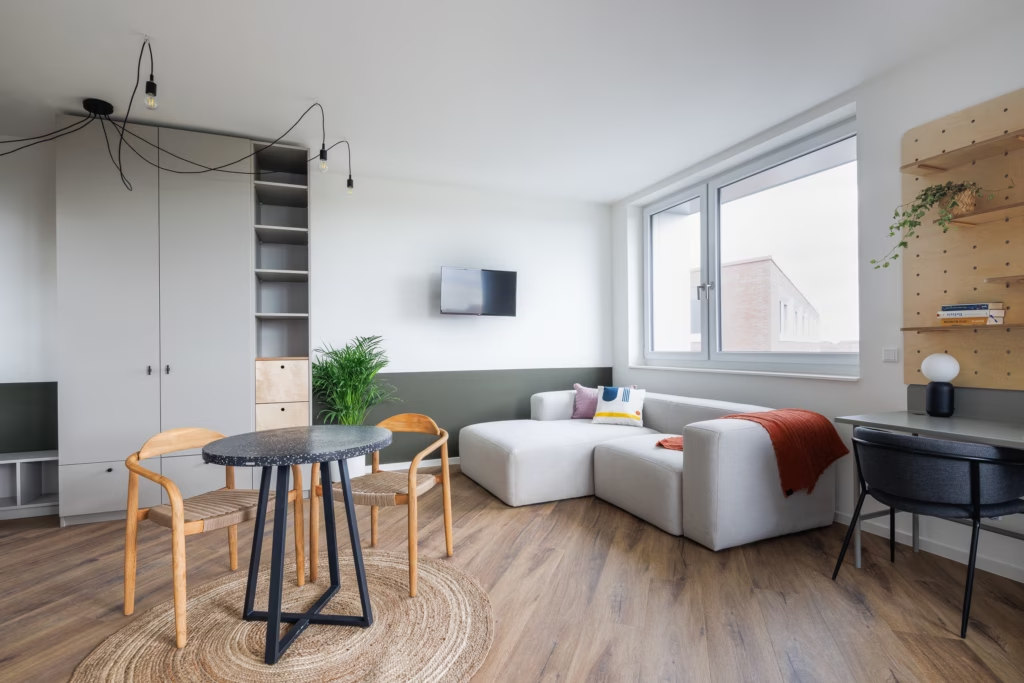
Living spaces at POHA House vary from small private studios to sharing apartments for up to six people

Simply but stylishly furnished, residents are encouraged to add their own touches of individuality
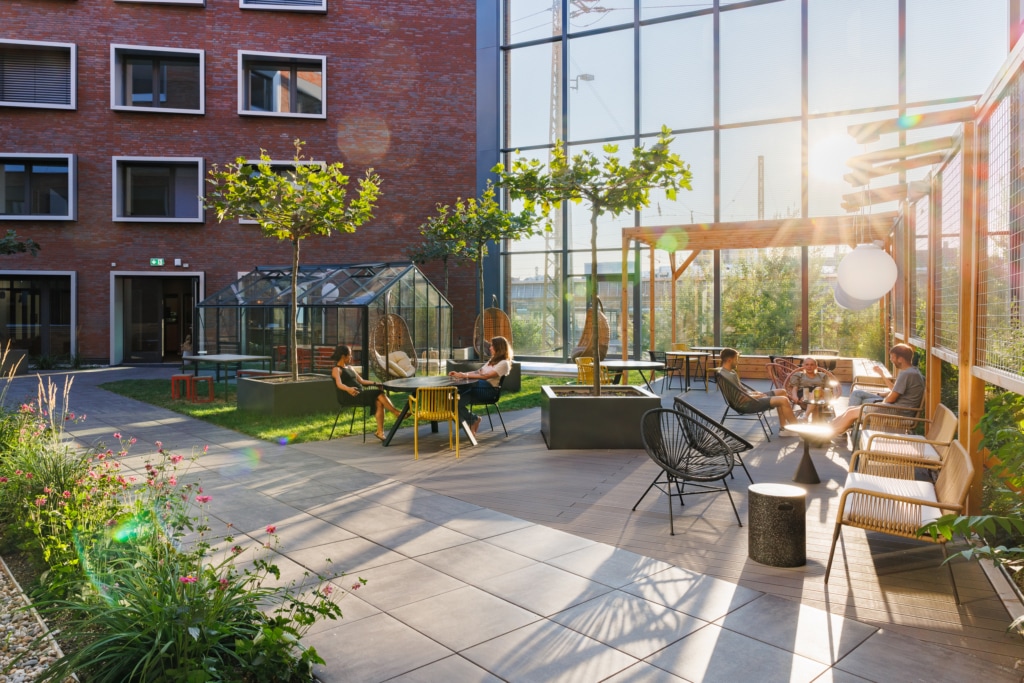
Relaxing on the terrace or working in the glasshouse, the residents also grow plants in the garden
Meet some of the residents of POHA House…
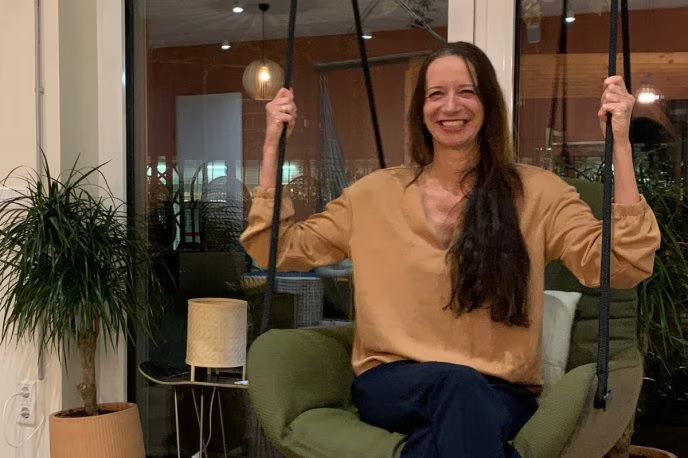
“I am 50 and I don’t feel too old here. I just feel good. It’s different, yes… but to be in this community is a choice.”
Svenja Eichenberg works as Head of Marketing for a European retail group
‘I changed my job, so I was looking for somewhere to live in Munster when I saw the new opening of POHA House and thought, “Oh, I’d like to test this!” I had a video interview with the team, they explained how it works, but what I really liked was the attitude. It was immediately clear to me this was something I wanted to be a part of.
People expect it to be for young people, but I am 50 and I don’t feel too old here. I just feel good. It’s different, yes, with different nationalities, different ages. But to be in this community is a choice.
I moved into a one-person studio, which is cosy, stylish and very much my taste, with modern, trendy furniture. Straight away it felt like being home. I just buy little bunches of flowers to add my personal touch.
I work a lot, and only really spend time in my studio for sleeping, and a couple of hours a day in the communal spaces. It’s very relaxing, and just like you are in your own living room. Everybody is always so friendly it feels like a family.
My favourite day each week is Wellness Wednesday. The day starts with a little jog, then there is breakfast on the terrace. I go to work, and when I come back there is a yoga class and maybe fresh juices afterwards, which for me is the perfect day. It’s always the same people who go, so here we also create our own little bit of community.
Things rarely go wrong because everybody tries to make this community work – it’s about respect. And it is very democratic. There are meetings when we can give feedback if there is something we want to change. Communication is good: we have an app where we get a lot of information so it’s very transparent and open.
During my professional life I have changed apartment maybe 10-15 times, and this is the first time I’ve ever considered co-living. I thought I’d only be here for three or four months to see if I liked it, but now it feels like the future.’
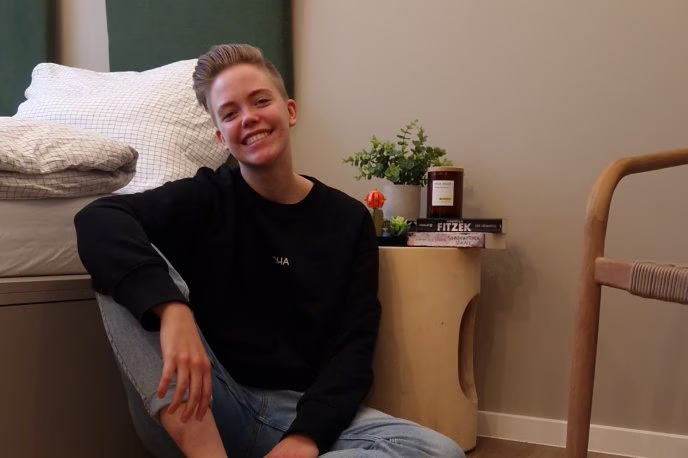
“I’ve been a dancer since I was a tiny human so I was chatting to the team about it and they said, ‘Well, don’t you want to do a ballet lesson with everyone?’”
Angelina Stockbrügger is studying to be a social worker
‘I’ve decorated my space so much that when you walk in you can tell that it’s me. I’ve got plants and photos, and postcards from friends, and two plushies from a girlfriend – it’s nice to have a part of her here. I also have a lot of plant LEGO which I love building when I’m stressed and need to focus on something. With my own things it feels like home for sure. Even in the community spaces we can talk about things we’d like – down to the board games – so we can incorporate our own identity there too which is really nice.
I’ve been a dancer since I was a tiny human so I was chatting to the team about it and they said, “Well, don’t you want to do a ballet lesson with everyone?” So I was like, “Sure! Why not?” So in the community area we’ll move the furniture and make a big open space where I’ll do that. I’m not saying I’m the best, but I enjoy dancing a lot and I love that they picked up on it. I feel like the community team really know me. And I think they really do try to make everyone happy.
I hang out in the community spaces with the close friends I’ve made, and we love to cook – maybe one day at mine, then switch to a friend’s. Sometimes a bit more space in the studio would be nice, like if I have a group of people to dinner, someone has to sit on the bed. I miss having my own oven. The bigger apartments have them, but I have a microwave with a grill function and sometimes I burn stuff with that, but we have two ovens in the big community kitchen which works out fine for me. We also have international dinners, because we have so many different nationalities here, and that’s always super-fun.
Up to this point I’ve lived with my parents in a very small town, so I’m learning how to be my own person and how to take care of myself, doing the everyday stuff like vacuuming twice a week – but I like that too. It feels like you live alone but you don’t live alone. I really appreciate having the support of others.’
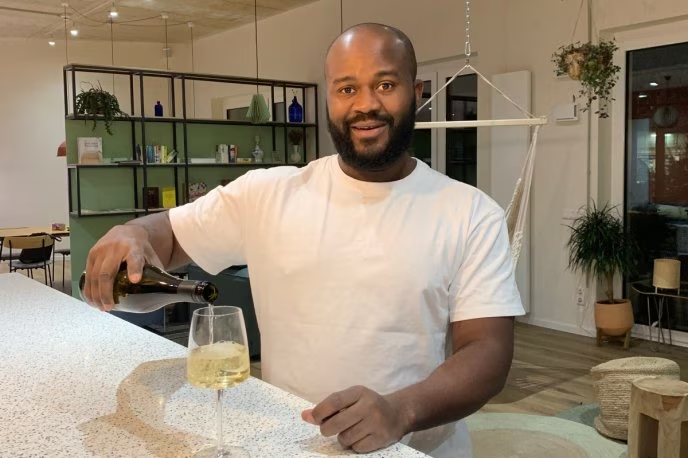
“For me this way of living is brilliant. I arrived with just my clothes, but I have everything I need.”
Jacques Decahou is an eBay reseller and has a shop in Munster
‘I was by myself in an apartment in a small town not far away, but I am an extrovert and being alone was not for me. So when I saw information about POHA House on the internet, I knew this new way of living was a great idea. And I love it. On my first day I made five new friends.
I still have an apartment on my own – I like having private space – but even in the open areas it feels like home. Every day in the communal living room, there is always something new and fun to do, or new people to meet. I talk to everybody, and with living here, I try to find out if people have an affinity with me for something, such as a love of sport, or we come up with ideas of things to do. I can go downstairs and say, “Tonight, does anyone fancy watching this film with me?” We have a cine-room, so we can go in there, have a beer, watch the movie together. Or, if I’m really tired, I won’t want to be in the shared space, so I’ll come to my room, do my own thing.
Each morning I go to my shop in the city, but in the afternoons I come back to POHA House and work in the shared space. Sitting next to a neighbour, we will work in silence, but then we’ll take a two or three minute pause to talk and then go back to work again. It is a good vibe.
For me this way of living is brilliant. I arrived with just my clothes, but I have everything I need. Nobody I know here wants to move. There is no reason to. I will definitely be staying here for a long time. I think it is very cool.’
With steep housing prices, escalating rents, the need for us all to own less and be more sustainable, co-living could well be the answer to many of our current accommodation issues. Combine that with a ready-made community of friends and stimulating events to attend, and there don’t seem to be many disadvantages. If the enthusiasm of the POHA House residents is anything to go by, everyone from students to empty-nesters will soon be vying for a space.
For more on POHA House, see pohahouse.com
Words: Mel Brodie
Photography of POHA House Munster by HEJM Photo
Residents photos courtesy of POHA House
